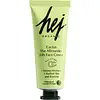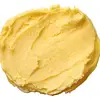What's inside
What's inside
 Key Ingredients
Key Ingredients

No key ingredients
 Benefits
Benefits

 Concerns
Concerns

 Ingredients Side-by-side
Ingredients Side-by-side

Water
Skin ConditioningGlycine Soja Oil
EmollientArgania Spinosa Kernel Oil
EmollientButyrospermum Parkii Butter
Skin ConditioningGlyceryl Stearate Citrate
EmollientIsoamyl Laurate
EmollientGlycerin
HumectantSimmondsia Chinensis Seed Oil
EmollientOpuntia Ficus-Indica Seed Oil
EmollientOlea Europaea Fruit Oil
MaskingOpuntia Ficus-Indica Flower Extract
Skin ConditioningCitrus Paradisi Fruit Extract
Skin ConditioningHelianthus Annuus Seed Oil
EmollientAcacia Senegal Gum
MaskingXanthan Gum
EmulsifyingSodium Hyaluronate
HumectantTocopherol
AntioxidantSodium Stearoyl Glutamate
CleansingSodium Levulinate
Skin ConditioningGlyceryl Caprylate
EmollientPotassium Sorbate
PreservativeSodium Anisate
AntimicrobialParfum
MaskingLimonene
PerfumingLinalool
PerfumingCitral
PerfumingCitronellol
PerfumingWater, Glycine Soja Oil, Argania Spinosa Kernel Oil, Butyrospermum Parkii Butter, Glyceryl Stearate Citrate, Isoamyl Laurate, Glycerin, Simmondsia Chinensis Seed Oil, Opuntia Ficus-Indica Seed Oil, Olea Europaea Fruit Oil, Opuntia Ficus-Indica Flower Extract, Citrus Paradisi Fruit Extract, Helianthus Annuus Seed Oil, Acacia Senegal Gum, Xanthan Gum, Sodium Hyaluronate, Tocopherol, Sodium Stearoyl Glutamate, Sodium Levulinate, Glyceryl Caprylate, Potassium Sorbate, Sodium Anisate, Parfum, Limonene, Linalool, Citral, Citronellol
Zea Mays Starch
AbsorbentArgania Spinosa Kernel Oil
EmollientTheobroma Cacao Seed Butter
EmollientMoringa Oleifera Seed Oil
EmollientRosa Rubiginosa Seed Oil
EmollientButyrospermum Parkii Butter
Skin ConditioningAniba Rosaeodora Wood Oil
AstringentViola Odorata Oil
MaskingVetiveria Zizanoides Root Oil
MaskingSantalum Album Oil
MaskingCitronellol
PerfumingEugenol
PerfumingLimonene
PerfumingLinalool
PerfumingBenzyl Benzoate
AntimicrobialParfum
MaskingGeraniol
PerfumingZea Mays Starch, Argania Spinosa Kernel Oil, Theobroma Cacao Seed Butter, Moringa Oleifera Seed Oil, Rosa Rubiginosa Seed Oil, Butyrospermum Parkii Butter, Aniba Rosaeodora Wood Oil, Viola Odorata Oil, Vetiveria Zizanoides Root Oil, Santalum Album Oil, Citronellol, Eugenol, Limonene, Linalool, Benzyl Benzoate, Parfum, Geraniol
Ingredients Explained
These ingredients are found in both products.
Ingredients higher up in an ingredient list are typically present in a larger amount.
You may know this ingredient as argan oil. Argan Oil has antioxidant, hydrating, and soothing properties.
Studies have shown argan oil can help fight again radical damage from the sun. This makes it effective at preventing hyperpigmentation.
Large amounts of vitamin E found in argan oil helps the skin retain water. Argan oil also contains fatty acids such as linoleic acid, oleic acid, and palmitic acid. It is also a good source of lipids.
Another benefit of argan oil is skin-soothing. It can help reduce inflammation-related skin symptoms.
Argan Oil is effective at regulating sebum production in pores. This can make it effective at treating hormonal acne.
Traditionally, argan oil was used for its antibacterial and antifungal properties. However, argan oil contains fatty acids that may make it not fungal-acne safe.
Argan Trees are native to Morocco.
Learn more about Argania Spinosa Kernel OilThis ingredient is also known as shea butter. It is an effective skin hydrator and emollient.
Emollients help soothe and soften your skin. It does this by creating a protective film on your skin. This barrier helps trap moisture and keeps your skin hydrated. Emollients may be effective at treating dry or itchy skin.
Shea butter is rich in antioxidants. Antioxidants help fight free-radicals, or molecules that may harm the body. It is also full of fatty acids including stearic acid and linoleic acid. These acids help replenish the skin and keep skin moisturized.
While Shea Butter has an SPF rating of about 3-4, it is not a sunscreen replacement.
Shea butter may not be fungal acne safe. We recommend speaking with a professional if you have any concerns.
Learn more about Butyrospermum Parkii ButterCitronellol is used to add fragrance/parfum to a product. It is often derived from plants such as roses. In fact, it can be found in many essential oils including geranium, lavender, neroli, and more. The scent of Citronellol is often described as "fresh, grassy, and citrus-like".
Since the Citronellol molecule is already unstable, Citronellol becomes irritating on the skin when exposed to air.
Citronellol is a modified terpene. Terpenes are unsaturated hydrocarbons found in plants. They make up the primary part of essential oils.
Citronellol is not able to be absorbed into deeper layers of the skin. It has low permeability,
Citronellol is also a natural insect repellent.
Learn more about CitronellolLimonene is a fragrance that adds scent and taste to a formulation.
It's found in the peel oil of citrus fruits and other plants such as lavender and eucalyptus. The scent of limonene is generally described as "sweet citrus".
Limonene acts as an antioxidant, meaning it helps neutralize free radicals.
When exposed to air, oxidized limonene may sensitize the skin. Because of this, limonene is often avoided by people with sensitive skin.
The term 'fragrance' is not regulated in many countries. In many cases, it is up to the brand to define this term. For instance, many brands choose to label themselves as "fragrance-free" because they are not using synthetic fragrances. However, their products may still contain ingredients such as essential oils that are considered a fragrance.
Learn more about LimoneneLinalool is a fragrance and helps add scent to products. It's derived from common plants such as cinnamon, mint, citrus, and lavender.
Like Limonene, this ingredient oxidizes when exposed to air. Oxidized linalool can cause allergies and skin sensitivity.
This ingredient has a scent that is floral, spicy tropical, and citrus-like.
Learn more about LinaloolParfum is a catch-all term for an ingredient or more that is used to give a scent to products.
Also called "fragrance", this ingredient can be a blend of hundreds of chemicals or plant oils. This means every product with "fragrance" or "parfum" in the ingredients list is a different mixture.
For instance, Habanolide is a proprietary trade name for a specific aroma chemical. When used as a fragrance ingredient in cosmetics, most aroma chemicals fall under the broad labeling category of “FRAGRANCE” or “PARFUM” according to EU and US regulations.
The term 'parfum' or 'fragrance' is not regulated in many countries. In many cases, it is up to the brand to define this term.
For instance, many brands choose to label themselves as "fragrance-free" because they are not using synthetic fragrances. However, their products may still contain ingredients such as essential oils that are considered a fragrance by INCI standards.
One example is Calendula flower extract. Calendula is an essential oil that still imparts a scent or 'fragrance'.
Depending on the blend, the ingredients in the mixture can cause allergies and sensitivities on the skin. Some ingredients that are known EU allergens include linalool and citronellol.
Parfum can also be used to mask or cover an unpleasant scent.
The bottom line is: not all fragrances/parfum/ingredients are created equally. If you are worried about fragrances, we recommend taking a closer look at an ingredient. And of course, we always recommend speaking with a professional.
Learn more about Parfum